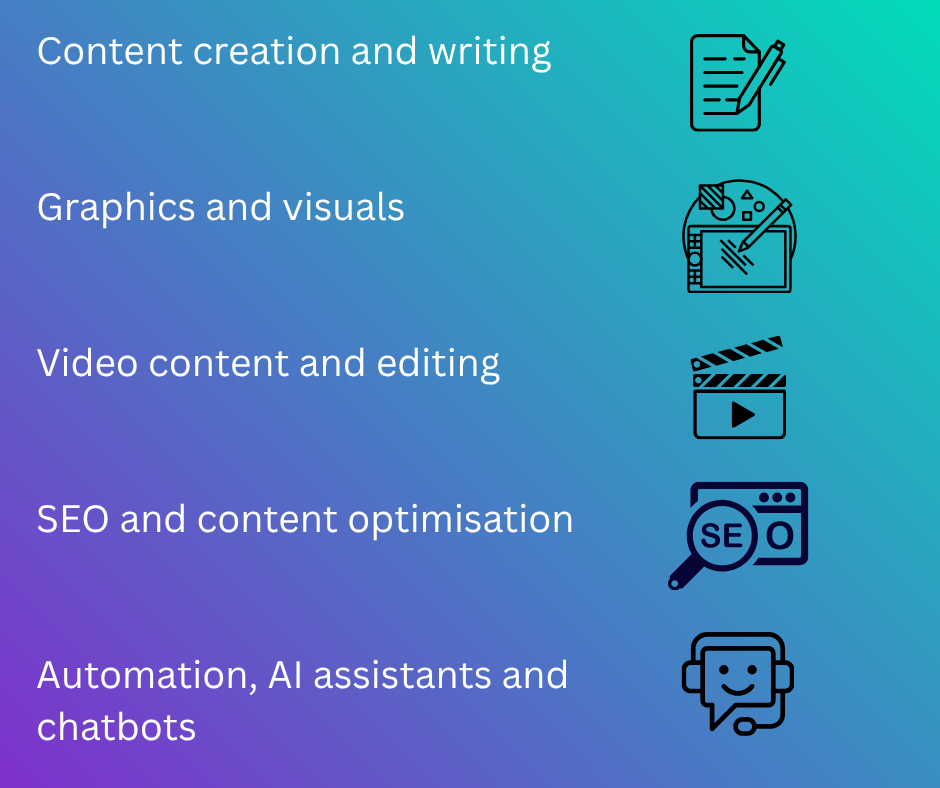Are you one of the thousands of people who are rather scared of AI but secretly envy all the people you see using it to help them in their careers and personal lives? Don’t worry, You are not alone! AI isn’t just changing the world – it’s changing the way we work, create, and build businesses. And no, it’s not just for coders and tech startups either. AI is for everyone and, no, I don’t believe it’s the first step on “The Terminator” ladder! From bloggers to course creators, spiritual mentors to side hustlers, AI is opening up a world of opportunities for all online entrepreneurs – especially those who are willing to learn and adapt. In this post, I’ll walk you through how to use AI to build an online business – with real examples, beginner tips, and some fascinating predictions for where things are heading.
Why AI matters for online entrepreneurs
Let’s start with the bigger picture. The global artificial intelligence market is expected to grow from $391 billion in 2025 to nearly $2 trillion by 2030, with a compound annual growth rate (CAGR) of over 36% (Grand View Research).
What does that mean for small business owners like us?
It means that AI isn’t a gimmick – it’s becoming the backbone of modern digital work. And while big businesses are investing heavily, solo entrepreneurs have just as much to gain.
A recent report from McKinsey found that 78% of organisations already use AI in at least one business area, up from 55% just two years earlier. And 92% of executives plan to increase AI investment in the next three years, with over half increasing spend by 10% or more. (See McKinsey report here.)
In short: the time to explore AI is now!
There are many different ways to use AI in your business, and you can start small (and for free!) and then build on your knowledge and successes as you learn more and become more confident. However, there are a few tools which I am using on a daily basis that I would recommend people to start with.
AI tools every online entrepreneur should know
There are hundreds of AI tools out there, but here are some of the most powerful and accessible for people running small online businesses. Even if you are not going to use these yourself at the moment, it is a good idea to make sure you understand what they are and what they do so that you can liaise with others. These tools are not going away but will become as much a household name as Word, PowerPoint and Google as they wend their merry way into our working lives.

Content creation and writing
- ChatGPT – Still one of the most versatile tools out there for generating blog posts, outlines, product descriptions, email copy, and more. (Tip: Use custom GPTs to fine-tune your tone or purpose.)
- Jasper – Ideal for sales pages, social ads and persuasive marketing content. Jasper includes brand voice options and campaign templates
- Notion AI – Helps summarise research, clean up messy drafts and manage your editorial planning directly inside your Notion workspace
- Claude (by Anthropic) – A rising star in the AI writing world. Known for handling long documents, complex thinking, and structured workflows with clarity and precision
- Grok (by xAI / Elon Musk) – Currently built into X (formerly Twitter), Grok mixes humour with information and can help summarise threads, explore trending topics, or even write posts with a bit of sass
- Claude (by Anthropic) is known for its calm, conversational tone and excels at handling large documents, complex reasoning, and structured workflows – making it a favourite among researchers, educators, and thoughtful content creators
- Gemini (by Google) – Gemini is great for pulling together info from across your Google Docs, Sheets, and Gmail to help you generate well-informed content, answers, and summaries
- DeepSeek, a powerful Chinese-developed AI model launched in 2025, has quickly gained attention for its open-weight release and strong performance on a surprisingly low training budget – making it a rising global competitor to ChatGPT and Claude
Graphics and visuals
- Canva Magic Studio – A dream tool for non-designers. Generate graphics, remove backgrounds, and turn text into beautifully branded images quickly and easily
- Midjourney – Known for its detailed, artistic-style images. Brilliant for featured blog graphics or unique visuals that stand out
- DALL·E (integrated in ChatGPT Plus) – Great for generating specific visuals, concept art or branded assets using text prompts. Now includes inpainting and editing options too
- Adobe Firefly – Designed for professionals who want to keep things on-brand. It works well for product mockups and high-res commercial visuals
Video content and editing
- Descript – Record, transcribe, and edit video or podcast content as if you’re working on a document. Ideal for repurposing long content into short, shareable pieces
- Pictory – Turns blog posts or text into videos with stock footage, voiceover and subtitles. Great for people who don’t want to be on camera
- CapCut AI – Super popular with TikTok and Reels creators. Offers trendy effects, filters, auto-captions, and AI-powered suggestions for short-form videos
- Runway ML – For more advanced creators. Offers AI video editing, image-to-video generation, and cinematic tools that are way more accessible than traditional software
- Lumen5 is a user-friendly video creation tool that turns blog posts and text into animated videos, complete with branding, music and subtitles – great for social sharing without needing to be on camera
- Synthesia allows you to create AI avatar videos from text, using lifelike presenters and multiple language options – ideal for tutorials, course content or explainer videos without filming yourself
SEO and content optimisation
- Surfer SEO – A powerful tool for blog writers who want to rank. Offers real-time keyword optimisation, structure tips and competitor comparisons
- Frase – Creates SEO-rich briefs, suggests headings and keywords, and gives detailed guidance on how to improve your content against others in the same niche
- NeuronWriter – Another up-and-coming SEO assistant, using NLP to suggest content improvements. Excellent for affordability and beginner-friendly layout
- Scalenut – Combines AI writing with SEO and keyword research. Includes a content planner for long-term strategies
Automation, AI assistants and chatbots
- Zapier – The king of automation. Link apps together and trigger actions automatically – from publishing content to saving leads
- Make (formerly Integromat) – A more visual and powerful automation tool if you need complex workflows or multiple-step triggers
- ManyChat – Build Instagram and Facebook Messenger bots that grow your list, share freebies, and interact with your audience on autopilot
- Chatbase – Create your own branded chatbot using existing content (like your blog or help centre). Great for customer support or digital products
- Perplexity AI – A research companion that answers questions and cites sources in real time. Great for drafting accurate, data-backed content without endless Googling
Try combining tools!
The real magic often happens when you stack tools together. For example:
- Use ChatGPT to draft an article
- Optimise it in Surfer SEO
- Turn it into a video with Pictory
- Create a visual teaser in Canva
- Schedule the lot with Zapier or Buffer
If that list feels overwhelming, don’t panic. The goal isn’t to use everything . It’s to choose one tool that solves one problem for you, and build from there.
Consider this metaphor. If you are undertaking a DIY job on your house, you want to have the right tools for the job. Sometimes you need a simple hammer, other times you need a wireless electric screwdriver; and sometimes you need a bench saw with interchangeable blades! Each has a job it does well. You wouldn’t use a hammer to saw piece of wood in half and you’ll never use your bench saw to fix your shelves to the wall. It’s ‘horses for courses’ as they say.

How AI helps grow your business
Here are some of the ways I’ve seen AI genuinely help people – especially those running solo businesses online:
- Saves time – write content quicker, generate post ideas, or schedule with automation
- Improves consistency – weekly emails, blog updates and reels are easier to keep going
- Helps create new products – like ebooks, journals, digital downloads and mini-courses
- Boosts visibility – improve SEO, repurpose content, and get found on more platforms
- Reduces overwhelm – lets you focus on what you love, while tech handles the rest
In other words, AI can be the assistant you didn’t know you could afford.
Important ethical considerations
Using AI doesn’t mean you stop being you. In fact, one of the biggest challenges – and opportunities – is to stay true to your voice while making the most of the tools.
Here are a few reminders:
- Use AI to support your ideas – not replace them. Let it suggest, but don’t let it dictate
- Check facts. AI can make mistakes so always check facts, references and links and if needed, do the research yourself the ‘old-fashioned’ way so you can be confident in your content
- Be transparent. If you use AI-generated images or quotes, say so
- Always review before publishing. Check facts, polish tone, and keep it aligned with your brand
- Remember your audience. People are looking for connection, not perfection
At its best, AI isn’t about faking it – it’s about freeing up your energy to create what matters most.
Beginner roadmap: How to start using AI today
 If you’re just getting started, here’s a simple plan:
If you’re just getting started, here’s a simple plan:
- Pick one area to try AI – content, design, or automation
- Test one free tool this week (e.g. Canva Magic Studio or ChatGPT)
- Set a tiny goal – write a blog post outline, create one social image, or try an AI script
- Reflect on the result – was it helpful? Does it save time? Does it feel authentic?
- Build it in gently – add it to your regular content flow bit by bit
Think of it like hiring a super-smart virtual assistant – one that never sleeps and doesn’t need coffee breaks (unless you do).
The future of AI in online business
OpenAI’s revenue has doubled to over $10 billion, with hundreds of millions of users creating content through platforms like ChatGPT, API tools, and integrations with Microsoft Copilot.
Meanwhile, revenue generated by the AI industry is projected to reach $1.3 trillion by 2032, and the SaaS (Software as a Service)/AI market could exceed $1.5 trillion by 2030. That means more tools, more capabilities – and more noise. But it also means more opportunity for people like us to stand out by staying real.
So the question is no longer if you should use AI. It’s how you can use it in a way that aligns with your values, your voice, and your vision.
And that’s where the magic happens.
And yes, if you are wondering, I used AI tools to help with writing, SEO and graphics!
Related posts
How to use AI tools to generate blog ideas, headlines and content
How to use AI for online business success: blogging and writing
VR Fashion Commerce: How Influencers Use Virtual Reality To Boost Style And Sales


Great info…
Man, this AI is crazy…
My daughter just saw a “dangerous accident” but it was a prank-then noticed it was an A video. Pffttt
Same goes with AI business… We need to be very careful and use it wisely and in a smart creative way.
I was scared of using AI before, but I have learned exactly what you just said; Use it as an advantage.
Hi Linda. Thanks for your comments. I’m glad you liked the post and I agree that somw people are using AI for negative things, but I think that’s the same for everything that’s ever been invented. Not sure if you can stop that but you can join the army of people using it for good – there are far more of those! All the best. Gail
I really appreciate how approachable this post makes AI feel, especially for those of us who aren’t Ai experts. The breakdown of tools by category is super helpful, and I didn’t realize how many different ways AI could support a solo business. The reminder to stay true to your own voice while using AI is such an important point. That DIY metaphor with the toolbox totally clicked for me. It’s a perfect way to explain using the right tools for the job. Which tool has helped you the most so far?
Hi Rob. Thanks for your kind comments and I’m so pleased that the article was useful to you. To answer your questions, I have found ChatGPT, Canva and Lumen 5 invaluable in my business so far and use the first two on a daily (any nightly!) basis. My advice is to start small with the free versions and then upgrade when you are comfortable. I have upgraded both Canva and Chat GPT and think they are worth every penny. All the best with your business.